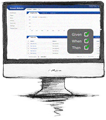

|









At exespec quality is at the heart of everything we do. We encourage a culture of quality right from the start and through each and every phase in the delivery lifecycle.
By implementing an effective quality assurance strategy, you can be confident that the final software product is delivered on time and to budget and will meet the business needs it was designed to address.
Requirements are fleshed out visually using wireframes mock-ups. The wireframes provide an excellent tool to facilitate communication between all team members. Ideas can be expressed quickly and clearly in such a way that everyone can understand.
The wireframes provide the starting point for software specification. As requirements get fleshed out, the wireframes are eventually discarded and replaced by a working prototype that truly brings the requirements to life.
Our exespec collaboration platform lets you take advantage of the extra reach that mobile computing can bring.
You can build specifications that target all types of devices. You can define requirements for web, desktop, tablet and mobile and all from the same integrated collaboration platform.
Not every development project is a green field project. Sometimes you will need to update legacy systems, where a machine readable specification is simply not available.
Although you may be able to get your hands on a traditional requirement document, there is no guarantee that it has been kept up-to-date, and hence cannot be relied upon.
In such circumstances, we can use reverse engineering tooling to generate an executable specification from your existing code base. This will give you the confidence to make changes in the knowledge that existing functionality will not be regressed.
Our exespec collaboration platform allows team members to track specification changes and monitor development progress as each scenario gets implemented. Post-it style soft-proofing tools allow team members to add comments, answer questions and request changes. Any changes need to be approved by the product owner before they can be incorporated into the specification and working prototype.


|
Unable to send your email! Please enter valid email address! Please fill out all the fields in order to send us a message. Your email has been successfully sent to exespec! |